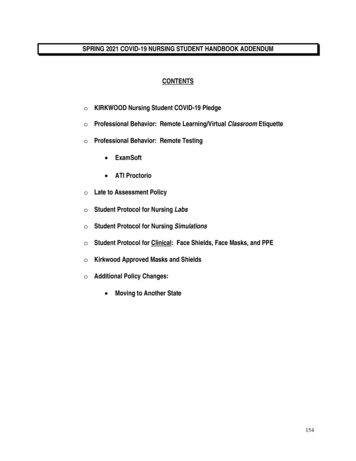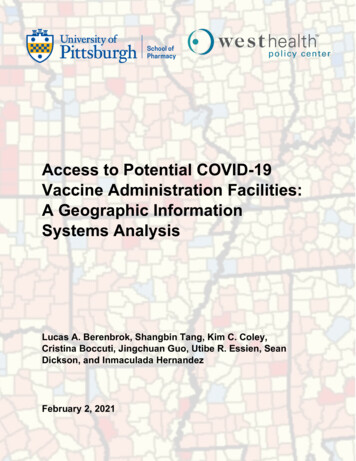
Transcription
Access to Potential COVID-19Vaccine Administration Facilities:A Geographic InformationSystems AnalysisLucas A. Berenbrok, Shangbin Tang, Kim C. Coley,Cristina Boccuti, Jingchuan Guo, Utibe R. Essien, SeanDickson, and Inmaculada HernandezFebruary 2, 2021
Access to Potential COVID-19 Vaccine Administration FacilitiesTABLE OF CONTENTSExecutive Summary . 3Introduction . 6Methods . 7Results . 8Discussion . 14References . 20LIST OF EXHIBITSTable 1 Summary Statistics for Facility Count at the County Level . 9Table 2 Counts of States with at least 80% and 90% of the Population within 1-, 2-, 5-,and 10-Miles Driving Distance to Closest Facility . 12Table 3 Counts and Proportions of Counties with at least 80% and 90% of thePopulation within 1-, 2-, 5-, and 10-Miles Driving Distance to Closest Facility . 12Table 4 List of Urban Counties Where Black Residents Were More Likely to Have aDriving Distance 1 Mile Compared to White Residents . 16Figure 1 Number of Facilities per 10,000 Residents. 10Figure 2 Mean Driving Distance to Closest Facility . 11Figure 3 Proportion of Population with Driving Distance Greater than 10 Miles fromClosest Facility . 13Figure 4 Proportion of Older Adults with a Driving Distance Greater than 10 miles fromthe Closest Facility . 14Figure 5 Counties Where Black Residents Were More Likely to Have a Driving Distance 1 Mile Compared to White Residents . 15Figure 6 Counties Where Black Residents Were More Likely to Have a Driving Distance 10 Miles Compared to White Residents . 17Page 2 of 22
Access to Potential COVID-19 Vaccine Administration FacilitiesEXECUTIVE SUMMARYIntroductionPreparedness and planning are of upmost importance to ensure a timely and equitableadministration of COVID-19 vaccines among the U.S. population. Geographicinformation systems analysis can be used to inform the design of vaccine distributionand administration plans. These analyses can identify limitations in the existing healthcare facility infrastructure to ensure that vaccines reach residents with low access tohealth care facilities.We conducted a geographic information systems analysis to quantify access to potentialCOVID-19 vaccine administration facilities, including community pharmacies, federallyqualified health centers, hospital outpatient departments, and rural health clinics. Todisseminate our findings, we developed an interactive visualization.MethodsWe used ArcGIS to map potential COVID-19 vaccine administration facilities, includingcommunity pharmacies that provided immunization services as of October 1, 2020,federally qualified health centers, hospital outpatient departments, and rural healthclinics. The U.S. population was characterized with the 2010 U.S. Synthetic Populationdeveloped by RTI International. For a 1% sample of the synthetic population, wecalculated the driving distance to the closest facility using ArcGIS Network Analyst anda national transportation dataset. We performed subgroup analyses for residents aged65 years or older.ResultsWe identified 68,128 potential COVID-19 vaccine administration facilities, including51,207 community pharmacies, 12,464 federally qualified health centers, 3,191 hospitaloutpatient departments, and 1,266 rural health clinics. The county-level mean (median)number of facilities per 10,000 residents was 2.8 (2.3). 37% of U.S. counties had 2 orfewer facilities per 10,000 residents, and 9% of U.S. counties had fewer than 1 facilityPage 3 of 22
Access to Potential COVID-19 Vaccine Administration Facilitiesper 10,000 residents. The highest concentrations of counties with fewer than 1 facilityper 10,000 residents were in Texas, Kansas, Nebraska, Virginia, and Montana.The mean driving distance to the closest potential vaccine administration facility was 2.2miles for the general population and 2.4 miles for residents aged 65 years or older.Across the U.S., nearly half of the population (49%) lived within 1 mile of a potentialadministration facility, 74% within 2 miles, 89% within 5 miles, and 97% within 10 miles.In 36 states, at least 80% of the population lived within 5 miles from a facility. In 45states, at least 90% of the population lived within 10 miles of a facility. Specifically, inNorth Dakota, South Dakota, Montana, Wyoming, Nebraska, and Kansas, over 10% ofthe population had a driving distance greater than 10 miles to the closest facility.State-level variation masked substantial variation at the county level. In 28% of U.S.counties, at least 80% of the population lived within 5 miles of a facility. In 49% ofcounties, at least 90% of the population lived within 10 miles of a facility. 32% of U.S.counties had at least 20% of residents with a driving distance greater than 10 miles tothe closest facility. Furthermore, 11% of counties had at least 50% of the populationwith a driving distance greater than 10 miles. The highest concentrations of countieswith at least 50% of the population with a driving distance greater than 10 miles were inTexas, Nebraska, Kansas, South Dakota, and Montana.We identified 69 counties where Black residents had a significantly higher risk thanWhite residents of having a driving distance greater than 1 mile to the closest potentialCOVID-19 vaccine administration facility. These 69 counties accounted for a totalpopulation of 26.3 million residents, including 6.6 million Black residents. The highestconcentrations of these counties were in GA (9), MS (7), AL (7), LA (6), TX (6), VA (6).A third of the counties with significant disparities were located in urban areas, includingFulton County, GA (Atlanta), DeKalb County, GA (Atlanta), Dallas County, TX (Dallas),Harris County, TX (Houston), Tarrant County, TX (Fort Worth), Wayne County, MI(Detroit), Orleans County, LA (New Orleans), and Queens County, NY (NYC). We alsoidentified 94 counties where Black residents had a significantly higher risk than Whiteresidents of having a driving distance greater than 10 miles to the closest facility. ThePage 4 of 22
Access to Potential COVID-19 Vaccine Administration Facilitieshighest concentrations of these counties were in VA (16), GA (10), SC (7), TX (7), AL(6), MS (6), NC (6).DiscussionThere exists large variation in population access to potential COVID-19 vaccineadministration facilities, particularly at the county level. This variation highlights the needfor public health officials to follow a data driven approach in tailoring vaccine distributionand administration plans to the limitations of existing local infrastructures. Ourinteractive visualization is an open access tool that may aid public health authorities inthe identification of geographic areas with lower access to existing health care facilitiesand that necessitate additional infrastructure for timely and equitable vaccineadministration.AcknowledgementsThis project was funded by the West Health Policy Center.We would like to thank Dr. David Kieran for his help with the conception of the studyand Kenneth Richardson for his assistance compiling facility data.Page 5 of 22
Access to Potential COVID-19 Vaccine Administration FacilitiesINTRODUCTIONPreparedness and planning are of upmost importance to ensure a timely and equitableadministration of COVID-19 vaccines among the population. The Centers for DiseaseControl and Prevention and the Department of Health and Human Services have calledupon state and local authorities to design vaccine distribution and administration plansthat address limitations of the existing health care infrastructure and ensure a timely andequitable vaccine administration to all individuals.1,2Geographic information systems (GIS) can be used to map population data in relation tocurrent health care facilities to assist state and local authorities in planning for morecomplete vaccination coverage during the COVID-19 pandemic. GIS analyses canidentify gaps in existing infrastructure, thereby empowering public health authorities withthe information needed to design vaccine distribution and administration plans thatensure that vaccines reach residents with low access to health care facilities.To this end, we mapped potential COVID-19 vaccine administration facilities across theU.S., including community pharmacies that provide immunization services, federallyqualified health centers, hospital outpatient departments, and rural health clinics. Ouranalyses focused on these facility types because each type has capacity to handle highvolume of vaccination over a short period of time. We used network analyses toestimate driving distance to the closest facility for a 1% sample of a synthetic populationof the U.S. For each county, we measured the proportion of population within 1, 2, 5,and 10 miles to the closest facility. We identified counties where a large proportion ofthe population had a long driving distance to the closest facility, or where Blackresidents were more likely to have a distance 1 mile or 10 miles to the closest facilitycompared to White residents. To disseminate our findings, we developed an interactiveopen access visualization that may aid state and local authorities in the identification ofareas with low access to the existing health care facility infrastructure.Page 6 of 22
Access to Potential COVID-19 Vaccine Administration FacilitiesMETHODSData SourcesWe obtained DataQ from the National Council for Prescription Drug Programs, acomprehensive data product that contains information for all community pharmacylocations in the U.S. We selected community pharmacies that provided immunizationservices as of October 1, 2020. We obtained from the Health Resources and ServicesAdministration the addresses of federally qualified health centers,3 and from the Centersfor Medicare and Medicaid Services the coordinates of rural health centers4 and theaddresses of hospital outpatient departments.5 The U.S. population was characterizedwith the publicly available 2010 U.S. Synthetic Population developed by RTIInternational.6,7 Finally, 2019 U.S. Census Bureau data was used to obtain most recentstate and county population estimates.8Analyses and OutcomesWe mapped facilities using ArcGIS, version 10.7 (Esri). For community pharmacies,federally qualified health centers, and hospital outpatient departments, the location wasgenerated with ArcGIS World Geocoding Service using address information (the ruralhealth clinic data contained facility coordinates). For a 1% random sample of the U.S.synthetic population (n 2,982,544), we calculated the driving distance in miles to theclosest facility within the state using ArcGIS Network Analyst and the U.S. GeologicalSurvey National Transportation Dataset.9For each county, we calculated counts of facilities; facility density, defined as thenumber of facilities per 10,000 residents; average driving distance to the closest facility;proportion of population within 1, 2, and 5 miles to the closest facility; proportion ofpopulation aged 65 years or older within 1, 2, and 5 miles to the closest facility;proportion of population with 10 miles distance to the closest facility; and proportion ofpopulation aged 65 years or older with 10 miles distance to the closest facility.Using the race data available in the Synthetic Population, we calculated the excess riskof having a distance 1 mile or 10 miles to the closest facility for Black compared toWhite residents at the county level. To test the significance of these associations, weconducted logistic regression models stratified by county that evaluated the associationPage 7 of 22
Access to Potential COVID-19 Vaccine Administration Facilitiesbetween race and distance 1 mile or 10 miles.Finally, we developed a risk score that combined the facility density and the proportionof population with driving distance less than 10 miles from a facility to stratify countiesby risk. The risk score ranges from 0 (lowest risk) to 6 (highest risk). To calculate therisk score, counties were categorized into quartiles of facility density and quartiles of theproportion of population less than 10 miles from a facility. The risk score was thencalculated as 8- quartile number for facility density -quartile number for population lessthan 10 miles from a facility. Counties in the first quartile of facility density (lowestdensity) and in the first quartile of proportion of population less than 10 miles from afacility (highest proportion with long driving distances) where assigned the highest risk(6). Counties in the fourth quartile of facility density (highest density) and in the fourthquartile of proportion of population less than 10 miles from a facility (lowest proportionwith long driving distances) where assigned the lowest risk (0).We developed an interactive visualization to display county-level estimates for counts offacilities, facility density, the proportion of population with 10 miles distance to theclosest facility, the proportion of population aged 65 years or older with 10 milesdistance to the closest facility, the excess risk of having a distance 10 miles to theclosest facility for Black compared to White residents, and the risk score.RESULTSFacility CountWe identified 68,128 potential COVID-19 vaccine administration facilities, including51,207 community pharmacies, 12,464 federally qualified health centers, 3,191 hospitaloutpatient departments, and 1,266 rural health clinics. The mean (median) number offacilities per county was 21.7 (7) and ranged from 0 to 1,548 (Table 1). The mean(median) number of community pharmacies providing immunizations per county was16.3 (4) and ranged from 0 to 1,055. One-fourth of U.S. counties had 3 or fewerpotential administration facilities.Page 8 of 22
Access to Potential COVID-19 Vaccine Administration FacilitiesTable 1 Summary Statistics for Facility Count at the County rally QualifiedHealth Centers4.0103Hospital OutpatientDepartments1.0001Rural HealthClinics0.4000All FacilityTypes21.77317Facility DensityAt the state level, the mean number of facilities per 10,000 residents was 2.3 (median,2.2), and was lowest in Nevada (1.6), Texas (1.6), Utah (1.7), California (1.7), andMinnesota (1.7). The highest facility density was present in West Virginia (4.6), Alaska(3.9), Vermont (3.5), Maine (3.4), and Kentucky (3.3). At the county level, the mean(median) number of facilities per 10,000 residents was 2.8 (2.3). 37% of U.S. counties(1,174 out of 3,142) had 2 or fewer facilities per 10,000 residents, and 9% of counties(283 out of 3,142) had fewer than 1 facility per 10,000 residents (Figure 1). The highestconcentrations of counties with fewer than 1 facility per 10,000 residents were in Texas(45), Kansas (33), Nebraska (32), Virginia (21), and Montana (19).Page 9 of 22
Access to Potential COVID-19 Vaccine Administration FacilitiesFigure 1 Number of Facilities per 10,000 ResidentsMean Driving Distance to Closest FacilityThe mean driving distance to the closest potential vaccine administration facility was 2.2miles for the general population and 2.4 miles for the population aged 65 years or older.At the state level, the mean driving distance to the closest facility was 2.8 miles(median, 2.6) and was lowest in the District of Columbia (0.4), New Jersey (1.1),California (1.2), New York (1.3), and Rhode Island (1.3). The mean driving distance tothe closest facility was highest in Montana (8.3), South Dakota (6.5), Wyoming (5.9),North Dakota (5.8), and Nebraska (4.0).At the county level, the mean driving distance to the closest facility was 6.5 (median,4.4) miles. The mean driving distance to the closest facility was greater than 5 miles in41% of U.S. counties (1,288 out of 3,142) and greater than 10 miles in 11% of counties(332 out of 3,142), Figure 2.Page 10 of 22
Access to Potential COVID-19 Vaccine Administration FacilitiesFigure 2 Mean Driving Distance to Closest FacilityProportion of Population within 1-, 2-, 5-, and 10-Miles Driving Distance to ClosestFacilityNearly half of the general population (49%) lived within 1 mile of a potential vaccineadministration facility, 74% within 2 miles, 89% within 5 miles, and 97% within 10 miles.Distances were similar for older adults, with 47% within 1 mile of a potentialadministration facility, 71% within 2 miles, 87% within 5 miles, and 96% within 10 miles.In 36 states, at least 80% of the population lived within 5 miles of a facility (Table 2). In45 states, at least 90% of the population lived within 10 miles of a facility. Specifically, inNorth Dakota, South Dakota, Montana, Wyoming, Nebraska, and Kansas, over 10% ofthe population had a driving distance greater than 10 miles to the closest facility.Page 11 of 22
Access to Potential COVID-19 Vaccine Administration FacilitiesTable 2 Counts of States with at least 80% and 90% of the Population within 1-, 2-, 5-, and10-Miles Driving Distance to Closest FacilityWithin 1 mileWithin 2 milesWithin 5 milesWithin 10 milesStates with at least80% of Population193649States with at least90% of Population111745State-level variation masked substantial variation at the county level: In 28% of counties(889 out of 3,142), at least 80% of the population lived within 5 miles of a facility (Table3). In 49% of counties (1531 out of 3,142), at least 90% of the population lived within 10miles of a facility.Table 3 Counts and Proportions of Counties with at least 80% and 90% of the Populationwithin 1-, 2-, 5-, and 10-Miles Driving Distance to Closest FacilityCounties with at least50% of PopulationCounties with at least80% of PopulationCounties with at least90% of PopulationWithin 1mileWithin 2 milesWithin 5 milesWithin 10 miles38412592256280538248889213719110482153132% of U.S. counties (1,005 out of 3,142) had at least 20% of residents with a drivingdistance greater than 10 miles to the closest facility, and 11% of counties (337 out of3,142) had at least 50% of residents with a distance greater than 10 miles. Countieswith at least 50% of residents with a driving distance greater than 10 miles wereconcentrated in Texas (45), Nebraska (40), Kansas (37), South Dakota (31), andMontana (28), Figure 3.Page 12 of 22
Access to Potential COVID-19 Vaccine Administration FacilitiesFigure 3 Proportion of Population with Driving Distance Greater than 10 Miles fromClosest FacilityThe proportion of older adults with a driving distance greater than 10 miles to theclosest facility presented a similar distribution to that of the general population: in NorthDakota and South Dakota, over 25% of older adults had a driving distance greater than10 miles to the closest facility. In Montana, Wyoming, Nebraska, and Kansas, over 15%of older adults had a driving distance greater than 10 miles to the closest facility.Nationally, one third of counties (1,049 out of 3,142) had at least 20% of older adultswith a driving distance greater than 10 miles to the closest facility. In 12.2% of counties(383 out of 3,142), at least 50% of older adults had a driving distance greater than 10miles to the closest facility. Counties with at least 50% of older adults with a drivingdistance greater than 10 miles were concentrated in Texas (47), Kansas (43), Nebraska(40), South Dakota (27), North Dakota (27), and Montana (25), Figure 4.Page 13 of 22
Access to Potential COVID-19 Vaccine Administration FacilitiesFigure 4 Proportion of Older Adults with a Driving Distance Greater than 10 miles fromthe Closest FacilityRacial Disparities in Access to Potential COVID-19 Vaccine AdministrationFacilitiesWe identified 69 counties, including 23 urban counties, where Black residents had asignificantly higher risk than White residents of having a driving distance greater than 1mile to the closest potential COVID-19 vaccine administration facility. These 69 countiesaccounted for a total population of 26.3 million residents, including 6.6 million Blackresidents. The highest concentrations of these counties were in GA (9), MS (7), AL (7),LA (6), TX (6), and VA (6), Figure 5.Page 14 of 22
Access to Potential COVID-19 Vaccine Administration FacilitiesFigure 5 Counties Where Black Residents Were More Likely to Have a Driving Distance 1 Mile Compared to White ResidentsTable 4 lists the 23 urban counties where Black residents had a significantly higher riskthan White residents of having a driving distance greater than 1 mile to the closestfacility. Urban counties were defined by codes 1 and 2 of the National Center for HealthStatistics urban-rural classification scheme for counties.10 Disparities were particularlylarge in Fulton County, GA and DeKalb County, GA, both of which are in the Atlantametropolitan area. The list also included counties that comprise major U.S. cities, suchas Dallas County, TX (Dallas), Harris County, TX (Houston), Tarrant County, TX (FortWorth), Wayne County, MI (Detroit), Orleans Parish, LA (New Orleans), and QueensCounty, NY (New York City).Page 15 of 22
Access to Potential COVID-19 Vaccine Administration FacilitiesTable 4 List of Urban Counties Where Black Residents Were More Likely to Have a Driving Distance 1 Mile Compared toWhite ResidentsCounty NameCrittendenSan eansPlaqueminesSt. BernardSt. John the BaptistPrince TarrantFredericksburg CityRichmondWilliamsMajor CityWestMemphisSan FranciscoBrookhavenAtlantaDallasKansas CityKennerNew OrleansBelle ChasseChalmetteLaPlaceBowieDetroitKansas CityQueensOklahoma CityColumbiaDallasHoustonFort WorthWinchesterWarsawManassasMajor NearbyCityMemphisAtlantaAtlantaNew OrleansNew OrleansNew OrleansNew OrleansWashington, DCNew York CityNashvilleWashington, DCPercentage BlackPopulation 1mileto Closest FacilityExcessRisk forBlack vsWhiteStatePopulationPercentage WhitePopulation 1mileto Closest e 16 of 22
Access to Potential COVID-19 Vaccine Administration FacilitiesWe identified 94 counties where Black residents had a significantly higher risk thanWhite residents of having a driving distance greater than 10 miles to the closest facility.The highest concentrations of these counties were in VA (16), GA (10), SC (7), TX (7),AL (6), MS (6), and NC (6), Figure 6. In 236 additional counties, Black residents had ahigher risk than White residents of having a driving distance greater than 10 miles to theclosest facility, but the difference between the two groups was not significant.Figure 6 Counties Where Black Residents Were More Likely to Have a Driving Distance 10 Miles Compared to White ResidentsDISCUSSIONTo our knowledge, ours is the first GIS analysis to quantify access to the existinginfrastructure of a wide range of health care facilities that may serve as locations forCOVID-19 vaccine administration. Our study demonstrates how GIS mapping can beused to guide the design of vaccine distribution and administration plans that overcomethe limitations of the existing infrastructure and ensure equitable distribution of COVID19 vaccines to all individuals.Page 17 of 22
Access to Potential COVID-19 Vaccine Administration FacilitiesWe observed large geographic variation in population access to potential COVID-19vaccine administration facilities, particularly at the county level. While only 3% of theU.S. population had a driving distance greater than 10 miles to the closest facility, asmany as 1,005 and 337 counties had more than 20% and 50% of county residents witha driving distance greater than 10 miles. These counties represented 4.2% (13.9 million)and 0.6% (1.9 million) of the entire U.S. population. This variation in accessdemonstrates the relevance of following a data-driven approach in the design ofvaccination plans and in the allocation of resources. The large county-level variationobserved within states reinforces the need for state and county authorities to collaboratein the development of targeted vaccination plans that overcome the limitations of thelocal infrastructure.Areas with higher facility density and thus higher potential vaccine administrationcapacity did not necessarily correspond to areas with lower average driving distance orwith racial disparities, which highlights the need for public health officials to tailorvaccine distribution and administration plans to both the limitations of existing facilityinfrastructure and population distribution. In areas with short driving distance yet lowfacility density, authorities may consider adding mass vaccination clinics to increasevaccination capacity and reduce time to vaccinate the desired proportion of the localpopulation. Conversely, areas with high driving distance to the closest facility maybenefit from deployment of mobile vaccination clinics to reduce travel-related barriers. Incounties where high driving distance is coupled with low facility density, as observed inTexas, Kansas, Nebraska, and Montana, mobile vaccine clinics administering singledose vaccines could be particularly effective, if single dose vaccines were available.Facility density and distance metrics can guide state and local authorities not only inidentifying the most appropriate strategy to increase capacity and convenience in eachjurisdiction but also in vaccine selection.Older adults have been included in Phase 1 recommendations for COVID-19vaccination by the Centers for Disease Control and Prevention.11 Our analysis highlightsareas where a higher proportion of older adults may have barriers to accessingvaccines. Such barriers are of major relevance because older adults are at higher riskfor severe COVID-19 disease and may be less likely or able to drive to vaccinePage 18 of 22
Access to Potential COVID-19 Vaccine Administration Facilitiesadministration locations. State and local authorities may use our estimates to allocateresources to increase vaccination rates among older adults. These resources couldinclude deployment of mobile vaccination units and working with community pharmaciesthat provide in-home vaccination services.Black Americans face disparities and barriers in the U.S. healthcare system thatdisproportionately affect Black individuals in comparison to White individuals. As anexample, our analysis highlights areas where Black individuals will have to travel fartherthan White individuals to receive COVID-19 vaccines. Increased drive times to receiveCOVID-19 vaccines may result in fewer vaccinations among Black individuals, and thus,further widen existing health disparities between Black and White Americans.12 Stateand local authorities may use our excess risk score for Black individuals in comparisonto White individuals to create opportunities for increased vaccine access for BlackAmericans. Opportunities may include the deployment of mobile vaccination units tocounties where Black individuals have a significantly higher risk than Whites of greaterdriving times for vaccination. Although our data focus on COVID-19 vaccineadministration, our findings demonstrate historical and ongoing disparities in access tohealthcare that should be addressed through the establishment of health care facilitiesin underserved neighborhoods and the improvement of public transportation. This isparticularly relevant since Black Americans are less likely to own a vehicle than WhiteAmericans.13LimitationsOur analysis is subject to seven main limitations. First, our network analyses wereperformed on a 1% sample of a synthetic population and thus do not provide a censusrepresentation of the U.S. population. Second, because at the time of study there wereno data available on which health care facilities would receive COVID-19 vaccines, wemapped facilities that could potentially serve as locations for vaccine administration. It ispossible that some of the facilities included in our analyses may not receive oradminister COVID-19 vaccines. For these reasons, our findings may not accuratelyrepresent true driving distances to receive COVID-19 vaccines. Third, our study did notinclude Indian Health Services facilities due to the unavailability of high-qualityPage 19 of 22
Access to Potential COVID-19 Vaccine Administration Facilitiesgeographic data, which may have upwardly biased driving distances in Arizona,Montana, and South Dakota. Additionally, our analyses did not evaluate how accesswould vary if physician office
administration of COVID-19 vaccines among the U.S. population. Geographic information systems analysis can be used to inform the design of vaccine distribution and administration plans. These analyses can identify limitations in the existing health care facility infrastructure to ensure that vaccines reach residents with low access to



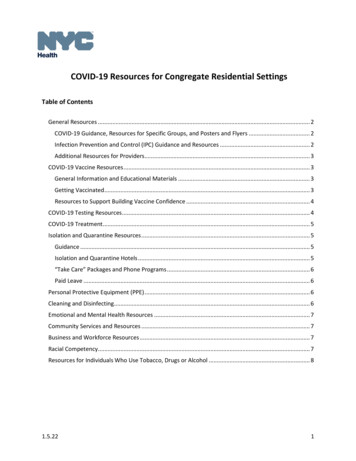
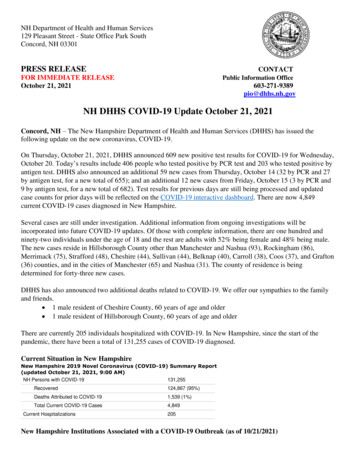
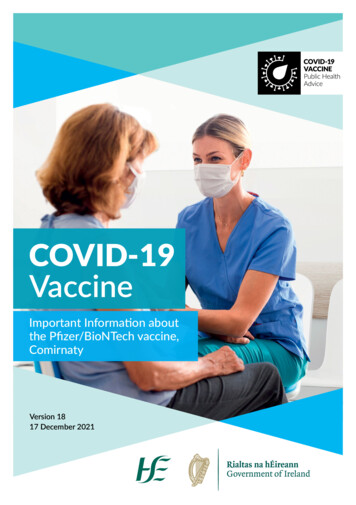
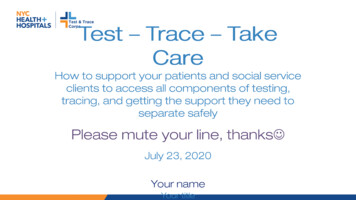
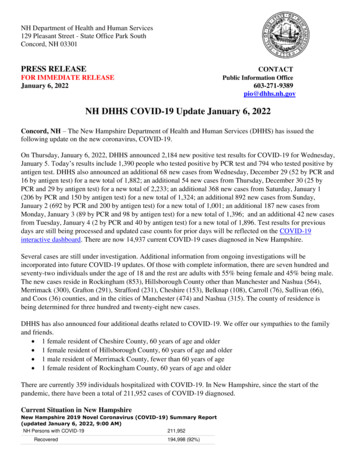


![2 CHAPTER 1 [Topic 1] Coulomb's law, electrostatic field and electric .](/img/52/physics.jpg)
